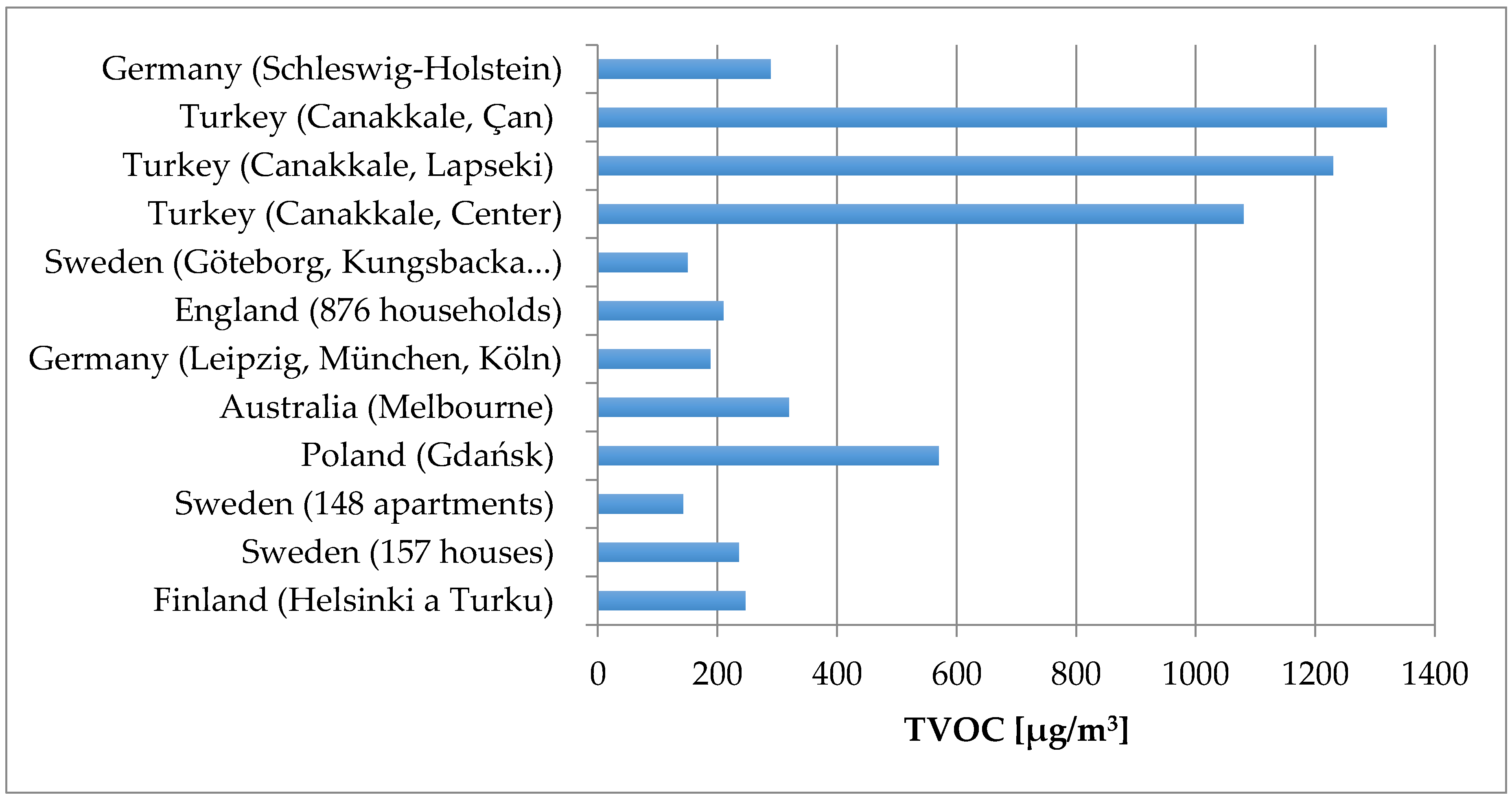Factors Effecting the Total Volatile Organic Compound (TVOC) Concentrations in Slovak Households
Abstract
:1. Introduction
2. Materials and Methods
2.1. Objective Measurement
2.2. Subjective Measurement
2.3. Statistical Analysis
2.4. Characteristics of Investigated Households
3. Results and Discussion
3.1. Subjective Measurement
3.2. Objective Measurement
3.3. Statistical Analysis
4. Conclusions
Acknowledgments
Author Contributions
Conflicts of Interest
Abbreviations
| TVOC | Total volatile organic compounds |
| VOCs | Volatile organic compounds |
| IAQ | Indoor air quality |
| I/O | Indoor/outdoor ratio |
| IEQ | Indoor environmental quality |
| LPG | Liquefied petroleum gas |
| CO2 | Carbon dioxide |
| Ta | Indoor air temperature |
| RH | Relative humidity |
| PM | Particulate matters |
| UV | Ultraviolet |
| To | Operative temperature |
| SBS | Sick building syndrome |
| NMDS | Non-metric multidimensional scaling |
| B1–B18 | Apartments 1–18 |
| D19–D35 | Family houses 19–35 |
| SF | Solid fuel heating |
| CH | Central heating |
| G | Gas boiler |
| O | Other types of heating |
| CO | Combination of materials |
| PC | Porous concrete |
| CS | Clay + stone |
| BB | Burnt brick |
| L | Laminate flooring |
| C | Carpet |
Appendix A
- 1.
- Year of construction of your residential building?
- 2.
- Was your residential building renovated?
- 3.
- If yes, when and what this renovation included?
- 4.
- Is your residential buildings thermally insulated?
- 5.
- If yes, what kind of thermal insulation?
- 6.
- On which floor is your apartment?
- 7.
- What is the total area of your apartment?
- 8.
- What is the floor area of the room where the measurement is carried out?
- 9.
- What is the ceiling height in the room where the measurement is carried out?
- 10.
- What is the number, size (width × height), window material in the room where the measurement is carried out?
- 11.
- What is the number, size (width × height), door material in the room where the measurement is carried out?
- 12.
- What is the orientation of the windows in this room?
- 13.
- What is the traffic density in the immediate vicinity of your apartment?
- 14.
- Does your apartment any damage due to moisture?
- 15.
- Do you have mould problems in your apartment?
- 16.
- Do you have mould problems in the room where the measurement is carried out?
- 17.
- What type of heating do you have in your apartment?
- 18.
- What type of ventilation do you have in your apartment?
- 19.
- What type of finishing (paint, wallpaper) is on the walls in the room where the measurement is carried out?
- 20.
- What type of floor is in the room where the measurement is carried out?
- 21.
- What type of furniture is in the room where the measurement is carried out?
- 22.
- How many plants there are in the room where the measurement is carried out?
- 23.
- Do you smoke indoors?
- 24.
- Do you use a moth balls in the room where the measurement is carried out?
- 25.
- Do you have newspapers or magazines in the room where the measurement is carried out?
- 26.
- Do you use air fresheners, scented candles, aromatic sticks, aromatic oils, etc.?
- 27.
- Do you use a printer or scanner in the room where the measurement is carried out?
- 28.
- Do you store toys in the room where the measurement is carried out?
- 29.
- Do you use art supplies in the room where the measurement is carried out?
- 30.
- Do you use cleaning agents for cleaning?
- 31.
- Do you use polishes or waxes for floors or furniture?
- 32.
- How often do you clean the room where the measurement is carried out?
- 33.
- Do you have open windows during cleaning?
- 34.
- Was your apartment renovated?
- 35.
- If yes, when was your apartment renovated?
- 36.
- What did this renovation included? (new plasters + paint, new wallpapers, new furniture, new floors...)
- 37.
- Have you ever heard about volatile organic compounds (VOCs)?
- 38.
- When purchasing building materials, paints and furniture, does the information on VOC emissions from the product play a role in your decision?
- 39.
- What is the main building material used to build your house?
- 40.
- Do you have a garage?
- 41.
- Is the garage connected to the house?
- 42.
- Is it possible to enter the house from the garage directly through the door?
- 43.
- Do you store paint, solvents, or gasoline in the garage?
- 1.
- Gender
- 2.
- Age
- 3.
- Smoking
- 4.
- How many people live in your household?
- 5.
- How much time do you spend at home per day?
- 6.
- Do you have a pet?
- 7.
- Do you have a problem with one of these factors at home? (yes, often/yes, sometimes/no, never)
- (a)
- Draught
- (b)
- Temperature too low
- (c)
- Temperature too high
- (d)
- Varying temperature
- (e)
- Stuffy (bad) air
- (f)
- Dry air
- (g)
- Unpleasant odour
- (h)
- Dust
- 8.
- Have you ever been diagnosed by a doctor to have asthma?
- 9.
- Have you ever been diagnosed by a doctor to have allergy?
- 10.
- Do you feel the following symptoms while you stay at home? (yes, often/yes, sometimes/no, never)
- (a)
- Fatigue
- (b)
- Heavy-headed
- (c)
- Headache
- (d)
- Dizziness
- (e)
- Difficulties in concentration
- (f)
- Itching, burning or irritation of eyes
- (g)
- Irritated, stuffy or runny nose
- (h)
- Dry or sore throat
- (i)
- Cough
- (j)
- Dry or flushed scalp or ears
- (k)
- Hand dry, itching, red skin
- (l)
- Memory impairment
Appendix B
| No. | Year of Construction | Thermal Insulation | Floor | Heating Type | Total Floor Area (m2) | Floor area in the Living Room (m2) | Flooring | Furniture | Surface Finishing of Walls/Ceiling | Renovation in Less Than 30 Weeks |
|---|---|---|---|---|---|---|---|---|---|---|
| B1 | 1984–1993 | no | >3rd | CH | ≥50 < 100 | 18 | L | particleboard | dispersive paint | no |
| B2 | 1955–1970 | yes | >3rd | CH | ≥50 < 100 | 16 | L | particleboard | dispersive paint | no |
| B3 | 1971–1983 | no | >3rd | CH | ≥50 < 100 | 20 | L | particleboard | dispersive paint | no |
| B4 | 1971–1983 | yes | >3rd | CH | <50 | 16 | L | wood | dispersive paint | no |
| B5 | after 1993 | yes | 1st–3rd | CH | ≥50 < 100 | 30 | L | wood | dispersive paint | no |
| B6 | 1955–1970 | yes | ground floor | CH | ≥50 < 100 | 18 | C | particleboard | dispersive paint | no |
| B7 | 1955–1970 | yes | ground floor | CH | ≥50 < 100 | 18 | C | particleboard | dispersive paint | no |
| B8 | 1955–1970 | no | 1st–3rd | CH | ≥50 < 100 | 35 | L | particleboard | dispersive paint | no |
| B9 | 1971–1983 | no | >3rd | CH | ≥50 < 100 | 25 | L | particleboard | dispersive paint | yes |
| B10 | 1984–1993 | yes | >3rd | CH | <50 | 15 | L | particleboard | dispersive paint | no |
| B11 | 1955–1970 | yes | ground floor | CH | ≥50 < 100 | 29 | C | particleboard | dispersive paint | no |
| B12 | 1971–1983 | yes | 1st–3rd | CH | <50 | 26 | L | particleboard | dispersive paint | no |
| B13 | before 1955 | no | 1st–3rd | O | ≥100 < 150 | 42 | O | wood | dispersive paint | yes |
| B14 | before 1955 | no | 1st–3rd | O | ≥100 < 150 | 35 | O | wood | dispersive paint | no |
| B15 | 1955–1970 | yes | ground floor | CH | <50 | 12 | C | particleboard | dispersive paint | no |
| B16 | 1984–1993 | no | >3rd | CH | ≥50 < 100 | 18 | L | particleboard | dispersive paint | no |
| B17 | 1955–1970 | yes | >3rd | CH | ≥50 < 100 | 23 | L | particleboard | dispersive paint | yes |
| B18 | 1984–1993 | no | >3rd | CH | ≥50 < 100 | 18 | L | particleboard | dispersive paint | no |
| No. | Number of Users | Pet | Traffic Density | Mould | Smoking Indoor | Fragrances | Plants | Cleaning Agents | Polishes/Waxes | Frequency of Cleaning | Opening Windows during Cleaning |
|---|---|---|---|---|---|---|---|---|---|---|---|
| B1 | 3–4 | no | medium | no | yes | yes | 8 | yes | no | once a week | no |
| B2 | ≤2 | yes | low | no | no | yes | 15 | yes | no | every 2–3 days | no |
| B3 | ≤2 | yes | low | no | no | yes | 2 | yes | no | every 2 weeks | yes |
| B4 | ≤2 | no | medium | yes | yes | yes | 0 | no | no | every 2–3 days | yes |
| B5 | ≤2 | yes | low | no | yes | yes | 4 | yes | yes | every 2–3 days | yes |
| B6 | ≤2 | no | medium | no | no | no | 2 | yes | no | every 2–3 days | yes |
| B7 | 3–4 | no | medium | yes | no | no | 8 | yes | no | every 2–3 days | yes |
| B8 | ≤2 | no | low | no | no | yes | 4 | yes | no | once a week | yes |
| B9 | 3–4 | no | medium | yes | no | no | 1 | yes | yes | every 2–3 days | yes |
| B10 | ≤2 | no | low | no | no | no | 0 | yes | no | once a week | yes |
| B11 | ≤2 | no | medium | no | no | no | 0 | yes | no | once a week | no |
| B12 | ≤2 | no | low | no | no | yes | 2 | yes | no | every 2–3 days | yes |
| B13 | ≤2 | yes | medium | yes | no | no | 6 | yes | no | every day | no |
| B14 | ≤2 | no | medium | no | yes | no | 5 | yes | no | once a week | no |
| B15 | ≤2 | yes | low | no | no | yes | 5 | yes | no | once a week | yes |
| B16 | >4 | yes | low | no | yes | yes | 0 | yes | no | every day | yes |
| B17 | 3–4 | no | high | no | no | no | 0 | yes | no | once a week | yes |
| B18 | 3–4 | no | medium | yes | no | no | 0 | yes | no | once a week | yes |
| No. | Year of Construction | Main Building Material | Thermal Insulation | Heating Type | Total Floor Area (m2) | Floor Area in the Living Room (m2) | Flooring | Furniture | Surface Finishing of Walls/Ceiling | Renovation in Less Than 30 Weeks | Garage | Attached Garage |
|---|---|---|---|---|---|---|---|---|---|---|---|---|
| D19 | 1955–1970 | CO | polystyrene | SF | ≥100 < 150 | 80 | L | wood | dispersive paint | no | no | no |
| D20 | after 1993 | PC | - | SF | ≥150 | 20 | L | particleboard | dispersive paint | no | yes | yes |
| D21 | 1955–1970 | CO | - | G | <50 | 12 | L | particleboard | dispersive paint | yes | no | no |
| D22 | before 1955 | CS | polystyrene | G | ≥50 < 100 | 20 | O | particleboard | dispersive paint | no | yes | no |
| D23 | before 1955 | CS | - | G | ≥150 | 25 | L | particleboard | dispersive paint | no | yes | no |
| D24 | before 1955 | CS | polystyrene | G | ≥50 < 100 | 15 | L | particleboard | dispersive paint | no | yes | no |
| D25 | 1971–1983 | BB | - | G | ≥100 < 150 | 20 | L | particleboard | dispersive paint | no | yes | yes |
| D26 | after 1993 | BB | polystyrene | SF | ≥150 | 42 | L | wood | dispersive paint | no | no | no |
| D27 | 1955–1970 | PC | polystyrene | SF | ≥150 | 23 | L | particleboard | dispersive paint | no | yes | no |
| D28 | after1993 | BB | mineral | O | ≥150 | 17 | L | particleboard | dispersive paint | no | no | no |
| D29 | 1955–1970 | BB | wool | G | ≥100 < 150 | 17 | C | particleboard | aluminium paint | no | yes | no |
| D30 | 1955–1970 | CS | polystyrene | G | ≥150 | 22 | L | particleboard | dispersive paint | no | no | no |
| D31 | after1993 | PC | wood fibre | O | ≥150 | 30 | O | wood | dispersive paint | no | no | no |
| D32 | after1993 | BB | polystyrene | G | ≥150 | 40 | L | particleboard | dispersive paint | no | yes | no |
| D33 | before 1955 | BB | - | SF | ≥100 < 150 | 18 | C | particleboard | dispersive paint | no | no | no |
| D34 | after1993 | BB | polystyrene | G | ≥150 | 89 | L | wood | dispersive paint | no | yes | yes |
| D35 | 1971–1983 | PC | polystyrene | G | ≥150 | 16 | L | particleboard | dispersive paint | no | yes | yes |
| No. | Direct Entry from Garage to the House | Storage of Paints, Solvents, or Gasoline in the Garage | Number of Users | Pet | Traffic Density | Mould | Smoking Indoor | Fragrance | Plant | Cleaning Agents | Polishes/Waxes | Frequency of Cleaning | Opening Windows during Cleaning |
|---|---|---|---|---|---|---|---|---|---|---|---|---|---|
| D19 | no | no | ≤2 | yes | low | no | yes | no | 10 | yes | no | every 2–3 days | yes |
| D20 | yes | yes | 3–4 | no | low | no | yes | no | 15 | yes | no | every day | no |
| D21 | no | no | ≤2 | no | low | no | no | no | 0 | yes | no | every 2–3 days | yes |
| D22 | no | yes | ≤2 | no | low | no | no | yes | 0 | yes | yes | once a week | yes |
| D23 | no | yes | >4 | no | low | no | no | no | 0 | yes | yes | once a week | yes |
| D24 | no | yes | 3–4 | no | low | no | no | yes | 2 | yes | yes | once a week | yes |
| D25 | yes | yes | >4 | no | low | yes | no | no | 2 | yes | no | once a week | no |
| D26 | no | no | >4 | no | low | no | no | no | 4 | yes | no | every day | no |
| D27 | no | yes | 3–4 | no | low | yes | yes | yes | 2 | yes | yes | every 2–3 days | yes |
| D28 | no | no | >4 | no | medium | no | no | no | 0 | no | no | once a week | yes |
| D29 | no | yes | ≤2 | no | low | yes | no | no | 0 | yes | no | once a week | no |
| D30 | no | no | 3–4 | yes | medium | no | no | no | 5 | yes | no | every day | yes |
| D31 | no | no | >4 | no | low | no | no | no | 18 | yes | no | once a week | yes |
| D32 | no | yes | 3–4 | no | medium | no | no | yes | 11 | yes | no | every day | yes |
| D33 | no | no | >4 | no | medium | yes | no | yes | 7 | yes | yes | every day | yes |
| D34 | yes | yes | 3–4 | no | high | no | yes | no | 5 | yes | yes | every 2–3 days | yes |
| D35 | yes | yes | 3–4 | yes | low | no | no | yes | 5 | yes | no | once a week | yes |
References
- Uchiyama, S.; Tomizawa, T.; Tokoro, A.; Aoki, M.; Hishiki, M.; Yamada, T.; Tanaka, R.; Sakamoto, H.; Yoshida, T.; Bekki, K.; et al. Gaseous chemical compounds in indoor and outdoor air of 602 houses throughout Japan in winter and summer. Environ. Res. 2015, 137, 364–372. [Google Scholar] [CrossRef] [PubMed]
- Harrison, R.M.; Thornton, C.A.; Lawrence, R.G.; Mark, D.; Kinnersley, R.P.; Ayres, J.G. Personal exposure monitoring of particulate matter, nitrogen dioxide, and carbon monoxide, including susceptible groups. Occup. Environ. Med. 2002, 59, 671–679. [Google Scholar] [CrossRef] [PubMed]
- Gokhale, S.; Kohajda, T.; Schlink, U. Source apportionment of human personal exposure to volatile organic compounds in homes, offices and outdoors by chemical mass balance and genetic algorithm receptor models. Sci. Total Environ. 2008, 407, 122–138. [Google Scholar] [CrossRef] [PubMed]
- Thatcher, T.L.; Layton, D.W. Deposition, resuspension and penetration of particles within a residence. Atmos. Environ. 1995, 29, 1487–1497. [Google Scholar] [CrossRef]
- Technical Report No. 6: BTEX Personal Exposure Monitoring in Four Australian Cities. Available online: https://www.environment.gov.au/system/files/resources/dc6c0439-ac47–4c53–981a-876fa8d8e6d4/files/report6.pdf (accessed on 11 October 2017).
- McCreddin, A.; Gill, L.; Broderick, B.; McNabola, A. Personal exposure to air pollution in office workers in Ireland: Measurement, analysis and implications. Toxics 2013, 1, 60–76. [Google Scholar] [CrossRef]
- Villanueva, F.; Tapia, A.; Amo-Salas, M.; Notario, A.; Cabañas, B.; Martínez, E. Levels and sources of volatile organic compounds including carbonyls in indoor air of homes of Puertollano, the most industrialized city in central Iberian Peninsula. Estimation of health risk. Int. J. Hyg. Environ. Health 2015, 218, 522–534. [Google Scholar] [CrossRef] [PubMed]
- Azuma, K.; Uchiyama, I.; Ikeda, K. The risk screening for indoor air pollution chemicals in Japan. Risk Anal. 2007, 27, 1623–1638. [Google Scholar] [CrossRef] [PubMed]
- Brown, S.K. Volatile organic pollutants in new and established buildings in Melbourne, Australia. Indoor Air 2002, 12, 55–63. [Google Scholar] [CrossRef] [PubMed]
- Tuomainen, M.; Tuomainen, A.; Liesivuori, J.; Pasanen, A.L. The 3-year follow-up study in a block of flats-experiences in the use of the Finish indoor climate classification. Indoor Air 2003, 13, 136–147. [Google Scholar] [CrossRef] [PubMed]
- Järnström, H.; Saarela, K.; Kalliokoski, P.E.A.; Pasanen, A.L. Reference values for indoor air pollutant concentrations in new, residential buildings in Finland. Atmos. Environ. 2006, 40, 7178–7191. [Google Scholar] [CrossRef]
- Park, J.S.; Ikeda, K. Variations of formaldehyde and VOC levels during 3 years in new and older homes. Indoor Air 2006, 16, 129–135. [Google Scholar] [CrossRef] [PubMed]
- Qian, K.; Zhang, Y.; Little, J.C.; Wang, X. Dimensionless correlations to predict VOC emissions from dry building materials. Atmos. Environ. 2007, 41, 352–359. [Google Scholar] [CrossRef]
- Shin, S.H.; Jo, W.K. Longitudinal variations in indoor VOC concentrations after moving into new apartments and indoor source characterization. Environ. Sci. Pollut. Res. 2013, 20, 3696–3707. [Google Scholar] [CrossRef] [PubMed]
- Liu, J.; Bai, G.; Chen, J.; Zhu, L.; Guo, W.; Shen, X. Total volatile organic compound concentration and its influencing factors in urban indoor air after decoration. Chin. Sci. Bull. 2011, 56, 2683–2689. [Google Scholar] [CrossRef]
- Noris, F.; Adamkiewicz, G.; Delp, W.W.; Hotchi, T.; Rusell, M.; Singer, B.C.; Spears, M.; Vermeer, K.; Fisk, W.J. Indoor environmental quality benefits of apartment energy retrofits. Build. Environ. 2013, 68, 170–178. [Google Scholar] [CrossRef]
- Langer, S.; Bekö, G.; Bloom, E.; Widheden, A.; Ekberg, L. Indoor air quality in passive and conventional new houses in Sweden. Build. Environ. 2015, 93, 92–100. [Google Scholar] [CrossRef]
- Langer, S.; Bekö, G. Indoor air quality in the Swedish housing stock and its dependence on building characteristics. Build. Environ. 2013, 69, 44–54. [Google Scholar] [CrossRef]
- Kumar, A.; Singh, B.P.; Punia, M.; Singh, D.; Kumar, K.; Jain, V.K. Determination of volatile organic compounds and associated health risk assessment in residential homes and hostels within an academic institute, New Delhi. Indoor Air 2014, 24, 474–483. [Google Scholar] [CrossRef] [PubMed]
- Dodson, R.E.; Levy, J.I.; Spengler, J.D.; Shine, J.P.; Bennett, D.H. Influence of basements, garages, and common hallways on indoor residential volatile organic compound concentrations. Atmos. Environ. 2008, 42, 1569–1581. [Google Scholar] [CrossRef]
- Lee, S.C.; Li, W.M.; Ao, C.H. Investigation of indoor air quality at residential homes in Hong Kong-case study. Atmos. Environ. 2002, 36, 225–237. [Google Scholar] [CrossRef]
- Guo, H.; Kwok, N.H.; Cheng, H.R.; Lee, S.C.; Hung, W.T.; Li, Y.S. Formaldehyde and volatile organic compounds in Hong Kong homes: Concentrations and impact factors. Indoor Air 2009, 19, 206–217. [Google Scholar] [CrossRef] [PubMed]
- Ventilation and Indoor Air Quality in New Homes. PIER Energy-Related Environmental Research Program. Collaborative Report. CEC-500–2009–085. Available online: https://www.arb.ca.gov/research/apr/past/04-310.pdf (accessed on 11 October 2017).
- Bari, M.A.; Kindzierski, W.B.; Wheeler, A.J.; Héroux, M.Ѐ.; Wallace, L.A. Source apportionment of indoor and outdoor volatile organic compounds at homes in Edmonton, Canada. Build. Environ. 2015, 90, 114–124. [Google Scholar] [CrossRef]
- Guo, H. Source apportionment of volatile organic compounds in Hong Kong homes. Build. Environ. 2011, 46, 2280–2286. [Google Scholar] [CrossRef]
- Jia, C.; Batterman, S.; Godwin, C. VOCs in industrial, urban and suburban neighbourhoods-part 2: Factors affecting indoor and outdoor concentrations. Atmos. Environ. 2008, 42, 2101–2116. [Google Scholar] [CrossRef]
- Ohura, T.; Amagai, T.; Shen, X.; Li, S.; Zhang, P.; Zhu, L. Comparative study on indoor air quality in Japan and China: Characteristics of residential indoor and outdoor VOCs. Atmos. Environ. 2009, 43, 6352–6359. [Google Scholar] [CrossRef]
- Hippelein, M. Background concentrations of individual and total volatile organic compounds in residential indoor air of Schleswig-Holstein, Germany. J. Environ. Monitor. 2004, 6, 745–752. [Google Scholar] [CrossRef] [PubMed]
- Mentese, S.; Mirici, N.A.; Otkun, M.T.; Bakar, C.; Palaz, E.; Tasdibi, D.; Cevizci, S.; Cotuker, O. Association between respiratory health and indoor air pollution exposure in Canakkale, Turkey. Build. Environ. 2015, 93, 72–83. [Google Scholar] [CrossRef]
- Raw, G.J.; Coward, S.K.; Brown, V.M.; Crump, D.R. Exposure to air pollutants in English homes. J. Expo. Sci. Environ. Epidemiol. 2004, 14, 85–94. [Google Scholar] [CrossRef] [PubMed]
- Schlink, U.; Rehwagen, M.; Damm, M.; Richter, M.; Borte, M.; Herbarth, O. Seasonal cycle of indoor-VOCs: Comparison of apartments and cities. Atmos. Environ. 2004, 38, 1181–1190. [Google Scholar] [CrossRef]
- Zabiegała, B.; Górecki, T.; Przyk, E.; Namieśnik, J. Permeation passive sampling as a tool for the evaluation of indoor air quality. Atmos. Environ. 2002, 36, 2907–2916. [Google Scholar] [CrossRef]
- Neupauerova, A.; Stevulova, N. Volatile Organic Compounds in Indoor Environment of Buildings. Doctoral Thesis, Technical University of Kosice, Kosice, Slovakia, 2002. [Google Scholar]
- Ergonomics of the Thermal Environment—Instruments for Measuring Physical Quantities. European Standard En ISO 7726: 1998; International Organization for Standardization: Geneva, Switzerland, 1998. [Google Scholar]
- Anderson, M.J.; Gorley, R.N.; Clarke, K.R. Permanova + for Primer: Guide to Software and Statistical Methods; PRIMER-E Ltd.: Plymouth, UK, 2008. [Google Scholar]
- Hollander, M.; Wolfe, D.A. Nonparametric Statistical Methods, 2nd ed.; John Wiley & Sons: New York, NY, USA, 1973. [Google Scholar]
- Regulation of Ministry of Health Slovak Republic No. 210/2016 Coll. on Detailed Requirements for Indoor Environment of Buildings and Minimum Requirements for Low-Standard Flats and Accommodation Facilities; Regulation of Ministry of Health: Bratislava, Slovak, 2016.
- Mølhave, L.; Nielsen, G.D. Interpretation and limitations of the concept “Total volatile organic compounds” (TVOC) as an indicator of human responses to exposures of volatile organic compounds (VOC) in indoor air. Indoor Air 1992, 2, 65–77. [Google Scholar] [CrossRef]
- Fechter, J.O.; Englund, F.; Lundin, A. Association between temperature, relative humidity and concentration of volatile organic compounds from wooden furniture in a model room. Wood Mater. Sci. Eng. 2006, 1, 69–75. [Google Scholar] [CrossRef]
- Vilcekova, S.; Sedlakova, A.; Turcsanyi, P.; Meciarova, L.; Kridlova Burdova, E.; Varga, J.; Roskova, P. Ultra-low-energy house and indoor environmental quality: A case study. Int. J. Energy Environ. 2016, 10, 171–180. [Google Scholar]
- Bornehag, C.-G.; Stridh, G. Volatile Organic Compounds (VOC) in the Swedish Housing Stock. In Proceedings of the Healthy Buildings 2000, Espoo, Finland, 6–10 August 2000. [Google Scholar]
- Nazaroff, W.W.; Weschler, C.J. Cleaning products and air fresheners: Exposure to primary and secondary air pollutants. Atmos. Environ. 2004, 38, 2841–2865. [Google Scholar] [CrossRef]
- Singer, B.C.; Destaillats, H.; Hodgson, A.T.; Nazaroff, W.W. Cleaning products and air fresheners: Emissions and resulting concentrations of glycol ethers and terpenoids. Indoor Air 2006, 16, 179–191. [Google Scholar] [CrossRef] [PubMed]
- Nørgaard, A.W.; Kudal, J.D.; Kofoed-Sørensen, V.; Koponen, I.K.; Wolkoff, P. Ozone-initiated VOC and particle emissions from a cleaning agent and an air freshener: Risk assessment of acute airway effects. Environ. Int. 2014, 68, 209–218. [Google Scholar] [CrossRef] [PubMed]
- Bartzis, J.; Wolkoff, P.; Stranger, M.; Efthimiou, G.; Tolis, E.I.; Maes, F.; Nørgaard, A.W.; Ventura, G.; Kalimeri, K.K.; Goelen, E.; et al. On organic emissions testing from indoor consumer products’ use. J. Hazard. Mater. 2015, 285, 37–45. [Google Scholar] [CrossRef] [PubMed]
- Thomas, K.W.; Pelizzari, E.D.; Clayton, C.A.; Perritt, R.L.; Dietz, R.N.; Goodrich, R.W.; Nelson, W.C.; Wallace, L.A. Temporal variability of benzene exposures for residents in several New Jersey homes with attached garages or tobacco smoke. J. Expos. Anal. Environ. Epidemiol. 1993, 3, 49–73. [Google Scholar]
- Lansari, A.; Strecher, J.J.; Huber, A.H.; Crescenti, G.H.; Zweidinger, R.B.; Duncan, J.W.; Weisel, C.P.; Burton, R.M. Dispersion of automotive alternative fuel vapors within a residence and its attached garage. Indoor Air 1996, 6, 118–126. [Google Scholar] [CrossRef]
- Murphy, J.D., Jr.; Beebe, J.; Kennedy, D. Building Code Amendment Justification Research: Poor Indoor Air Quality Mitigation Relative to Attached Garages. In Proceedings of the 33rd American Security Council (ACS) Annual Conference; University of Washington: Seattle, DC, USA, 1997. [Google Scholar]
- Graham, L.A.; Noseworthy, L.; Fugler, D.; O’Leary, K.; Karman, D.; Grande, C. Contribution of vehicle emissions from an attached garage to residential indoor air pollution levels. J. Air Waste Manag. Assoc. 2004, 54, 563–584. [Google Scholar] [CrossRef] [PubMed]
- Tsai, P.Y.; Weisel, C.P. Penetration of evaporative emissions into a home from an M85-fueled vehicle parked in an attached garage. J. Air Waste Manag. Assoc. 2000, 50, 371–377. [Google Scholar] [CrossRef] [PubMed]
- Emmerich, S.J.; Gorfain, J.E.; Howard-Reed, C. Air and pollutant transport from attached garages to residential living spaces-literature review and field tests. Int. J. Vent. 2003, 2, 265–276. [Google Scholar] [CrossRef]
- Batterman, S.; Jia, C.; Hatzivasilis, G.; Godwin, C. Simultaneous measurement of ventilation using tracer gas techniques and VOC concentrations in homes, garages and vehicles. J. Environ. Monitor. 2006, 8, 249–256. [Google Scholar] [CrossRef] [PubMed]
- Batterman, S.; Jia, C.; Hatzivasilis, G. Migration of volatile organic compounds from attached garages to residences: A major exposure source. Environ. Res. 2007, 104, 224–240. [Google Scholar] [CrossRef] [PubMed]
- Jo, W.K.; Kim, K.Y.; Park, K.H.; Kim, Y.K.; Lee, H.W.; Park, J.K. Comparison of outdoor and indoor mobile source-related volatile organic compounds between low-and high-floor apartments. Environ. Res. 2003, 92, 166–171. [Google Scholar] [CrossRef]
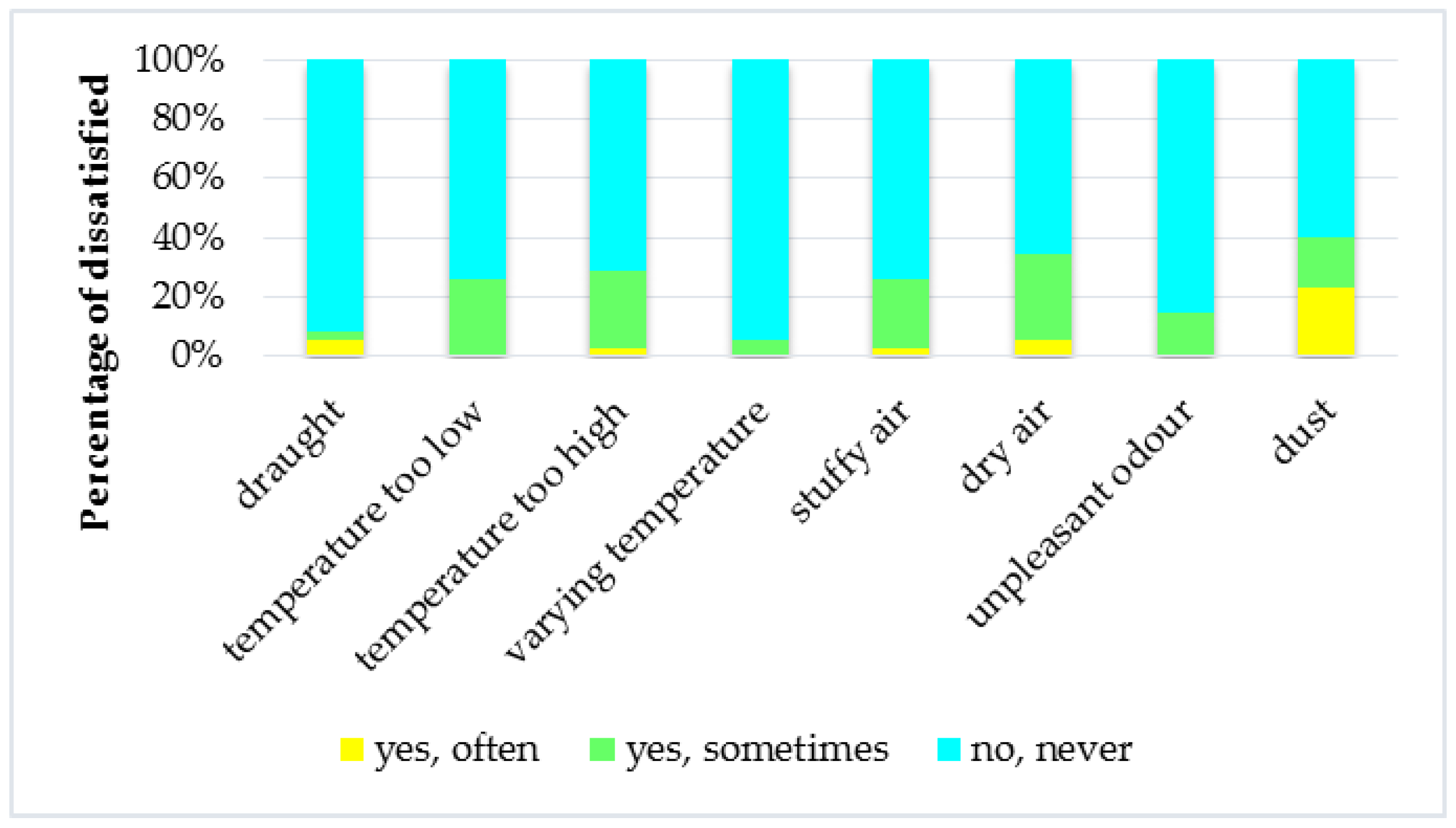
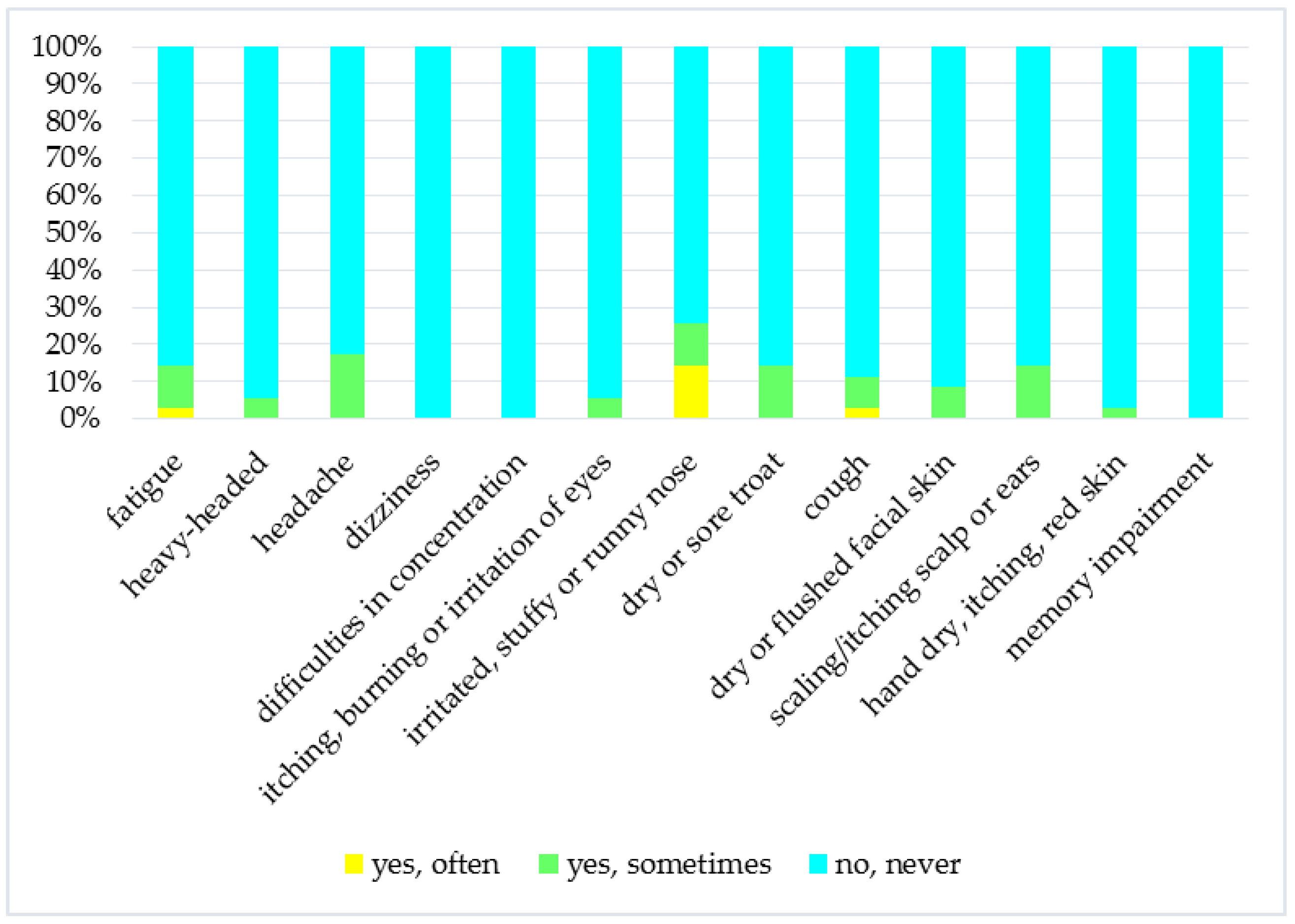
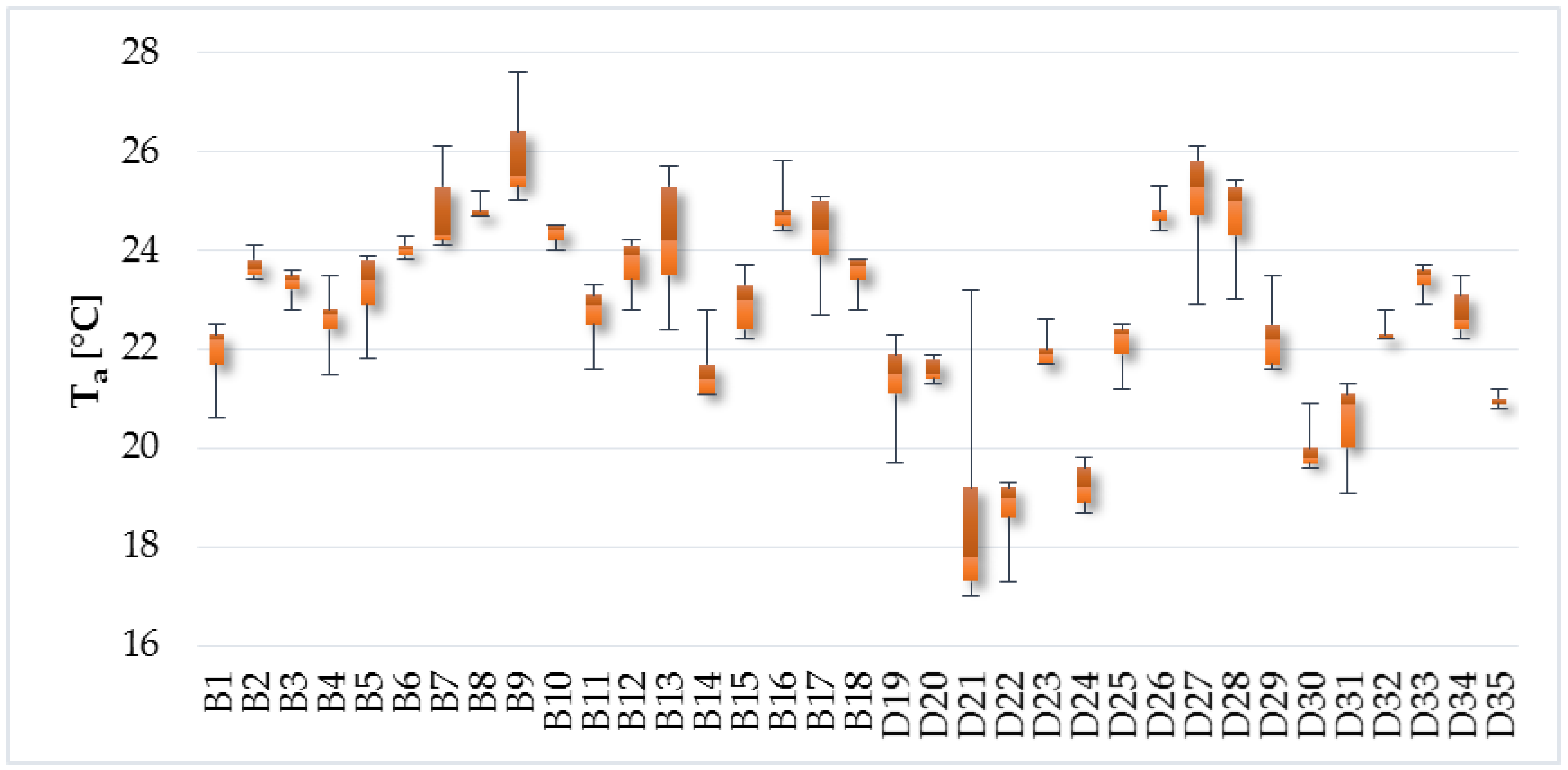
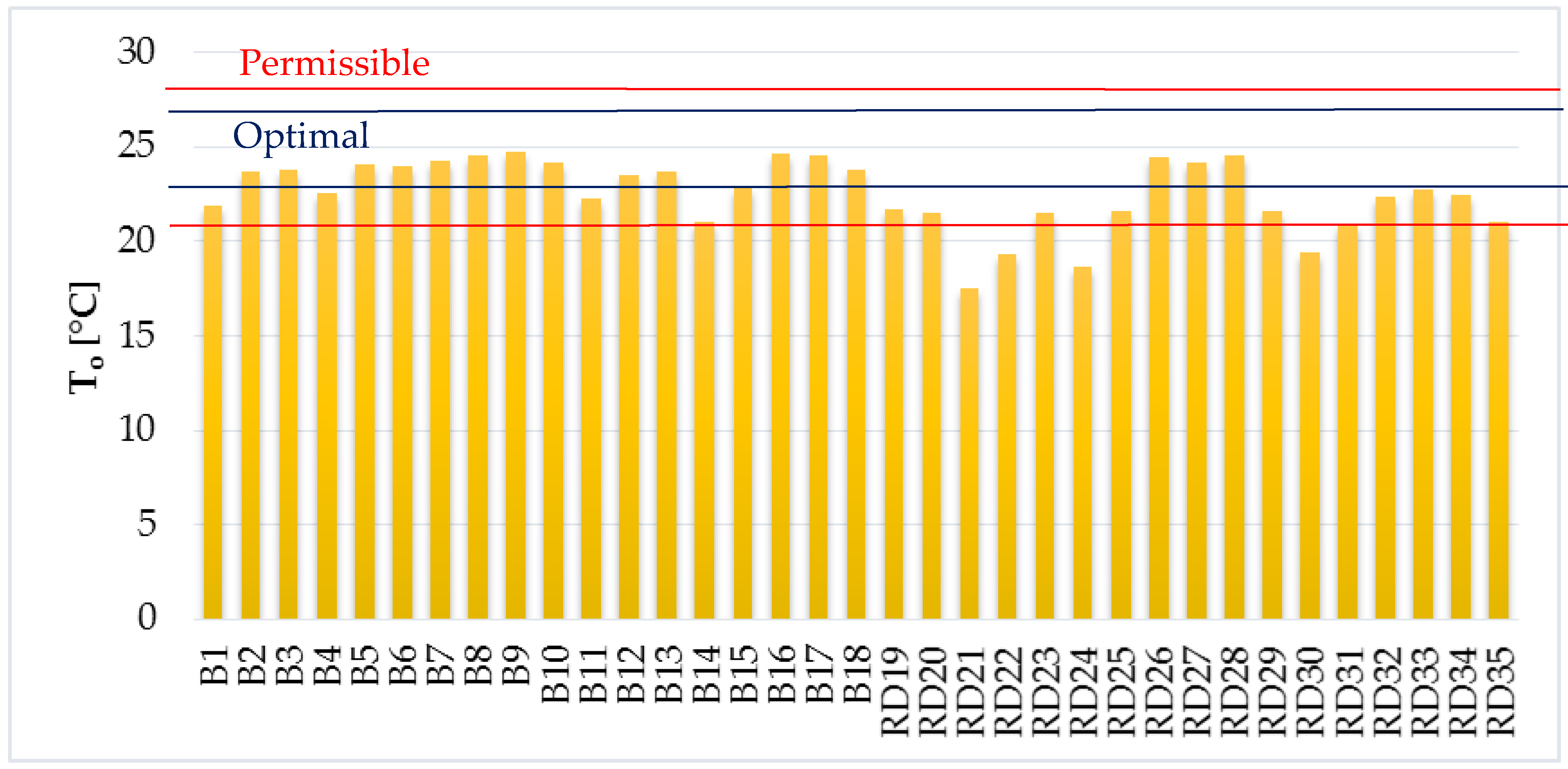
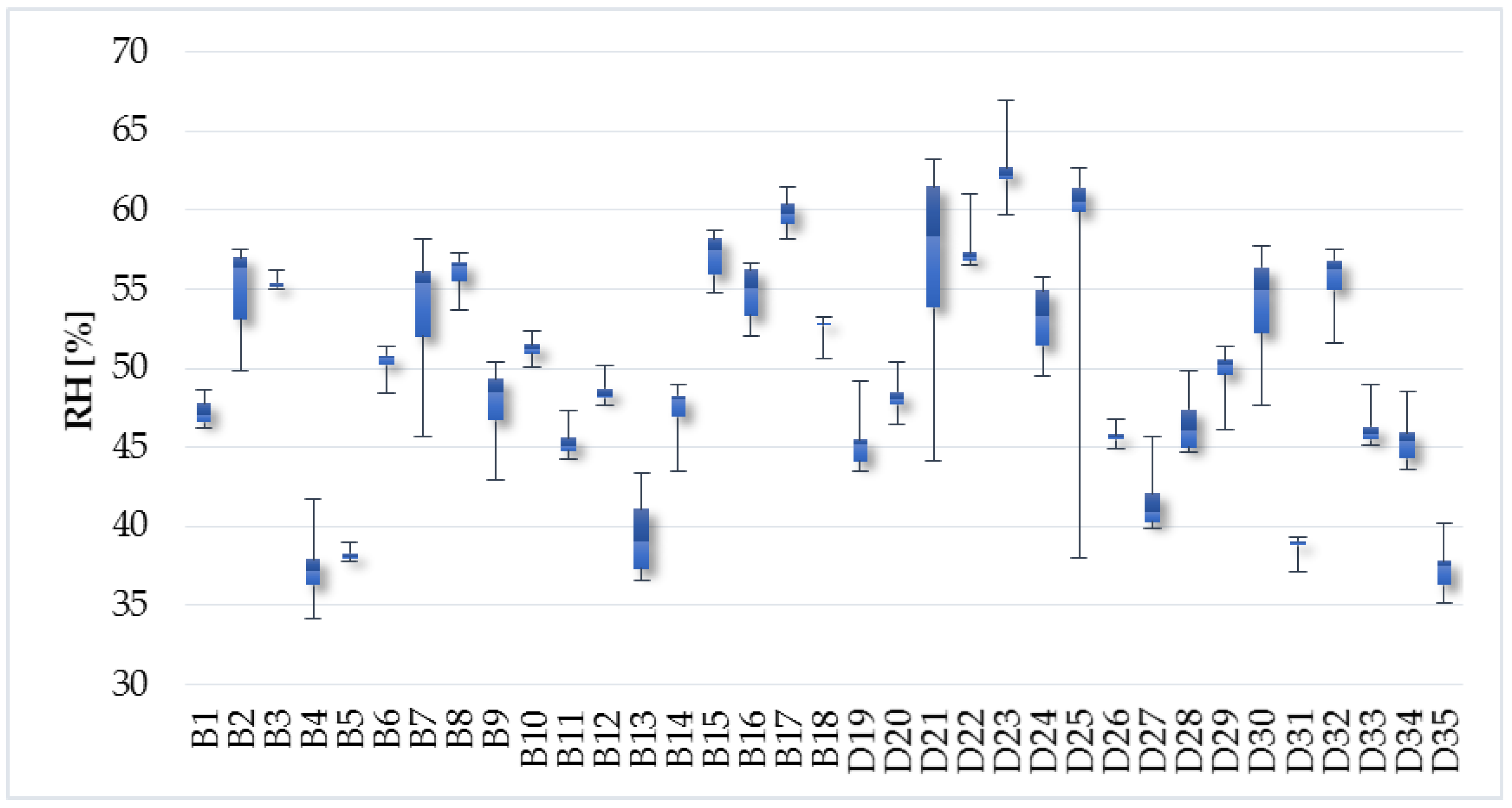
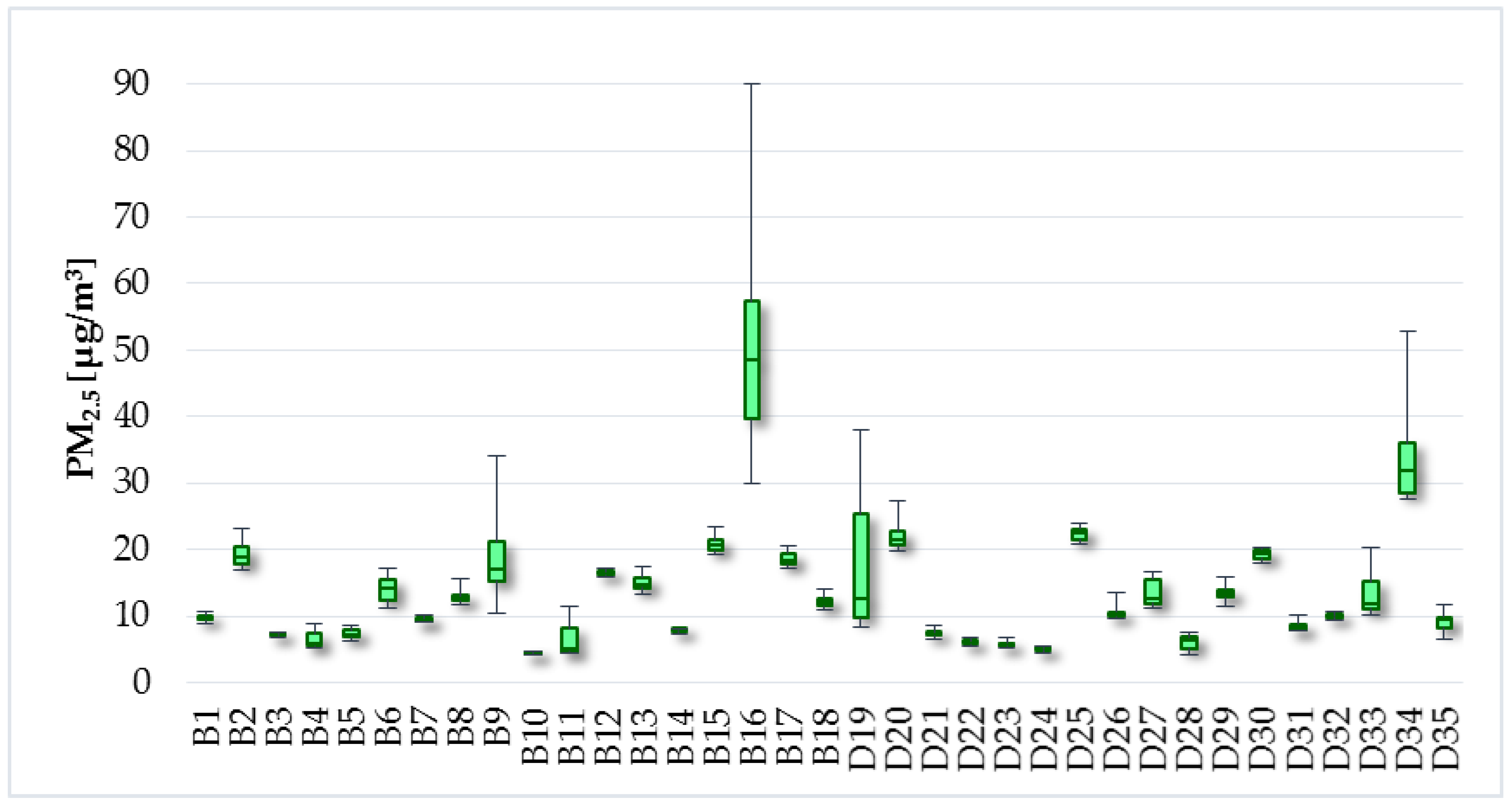
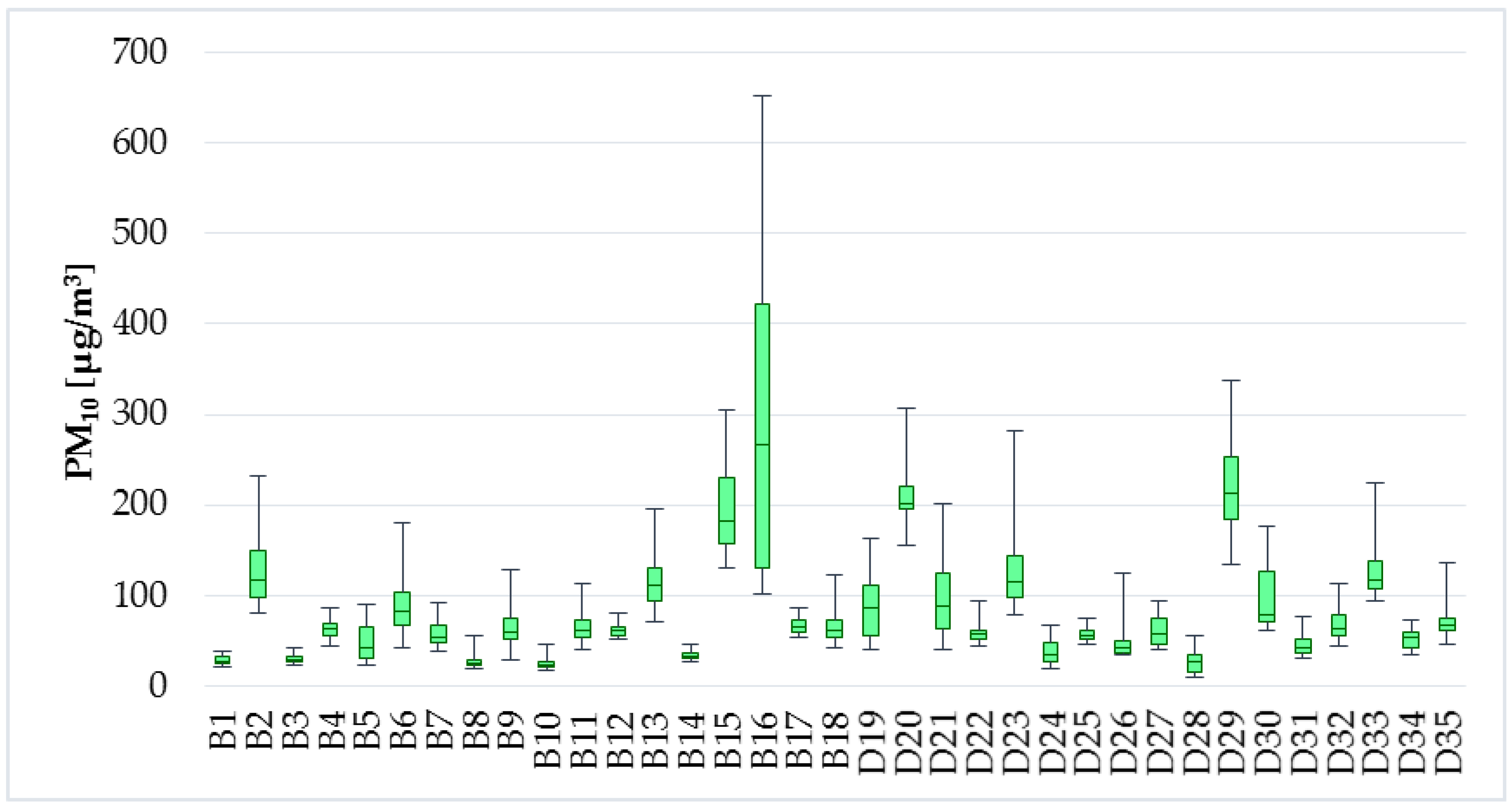


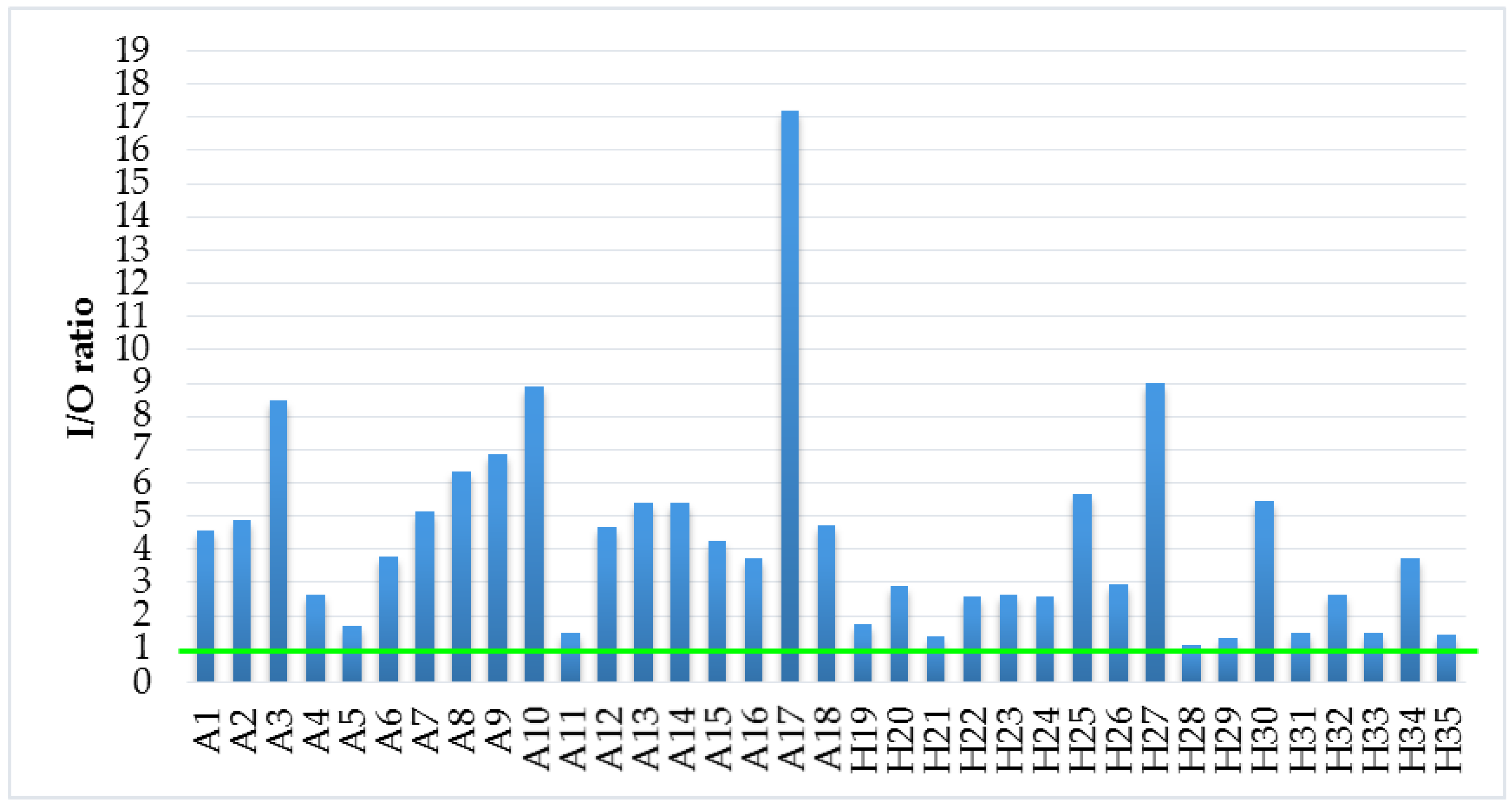
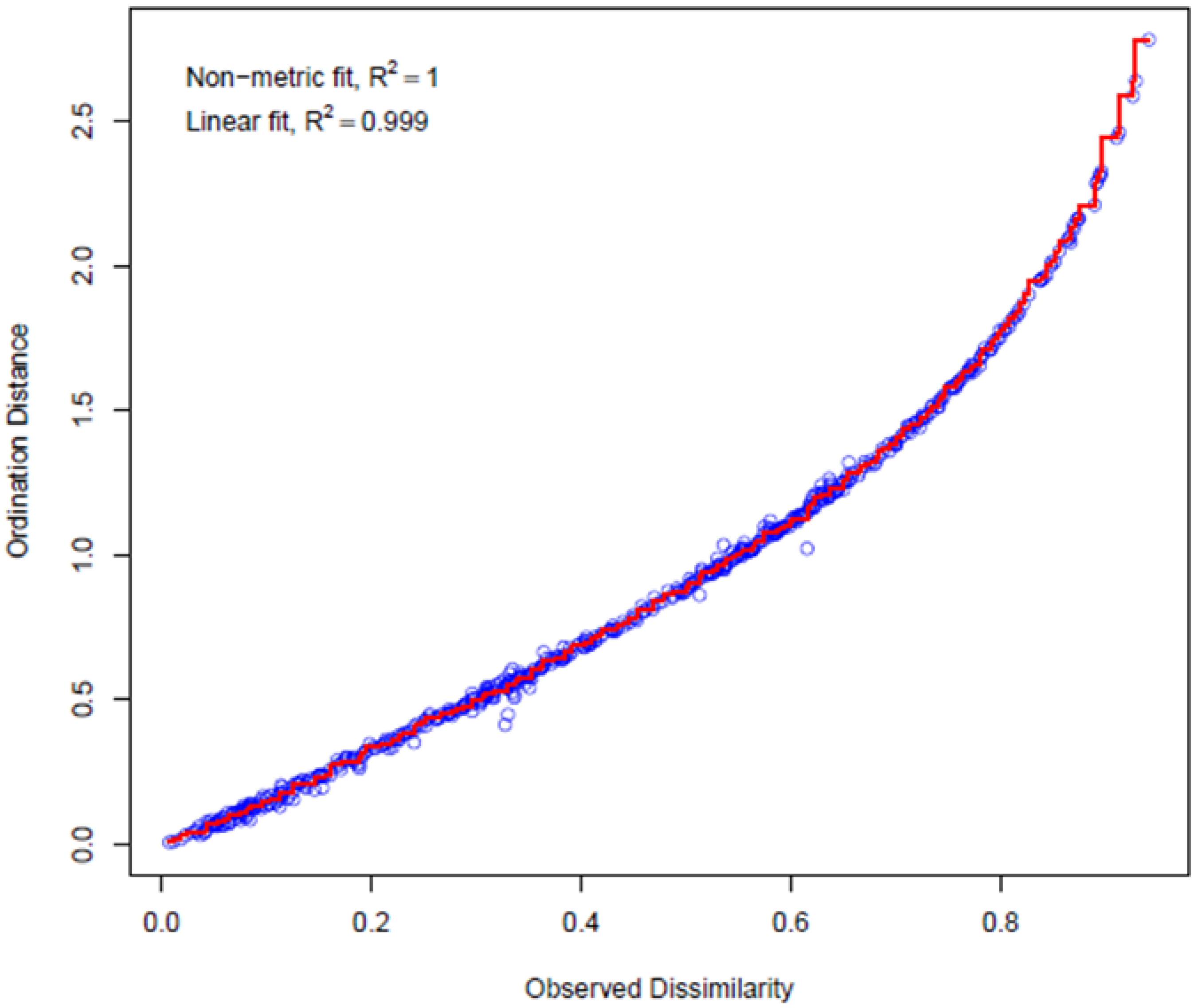
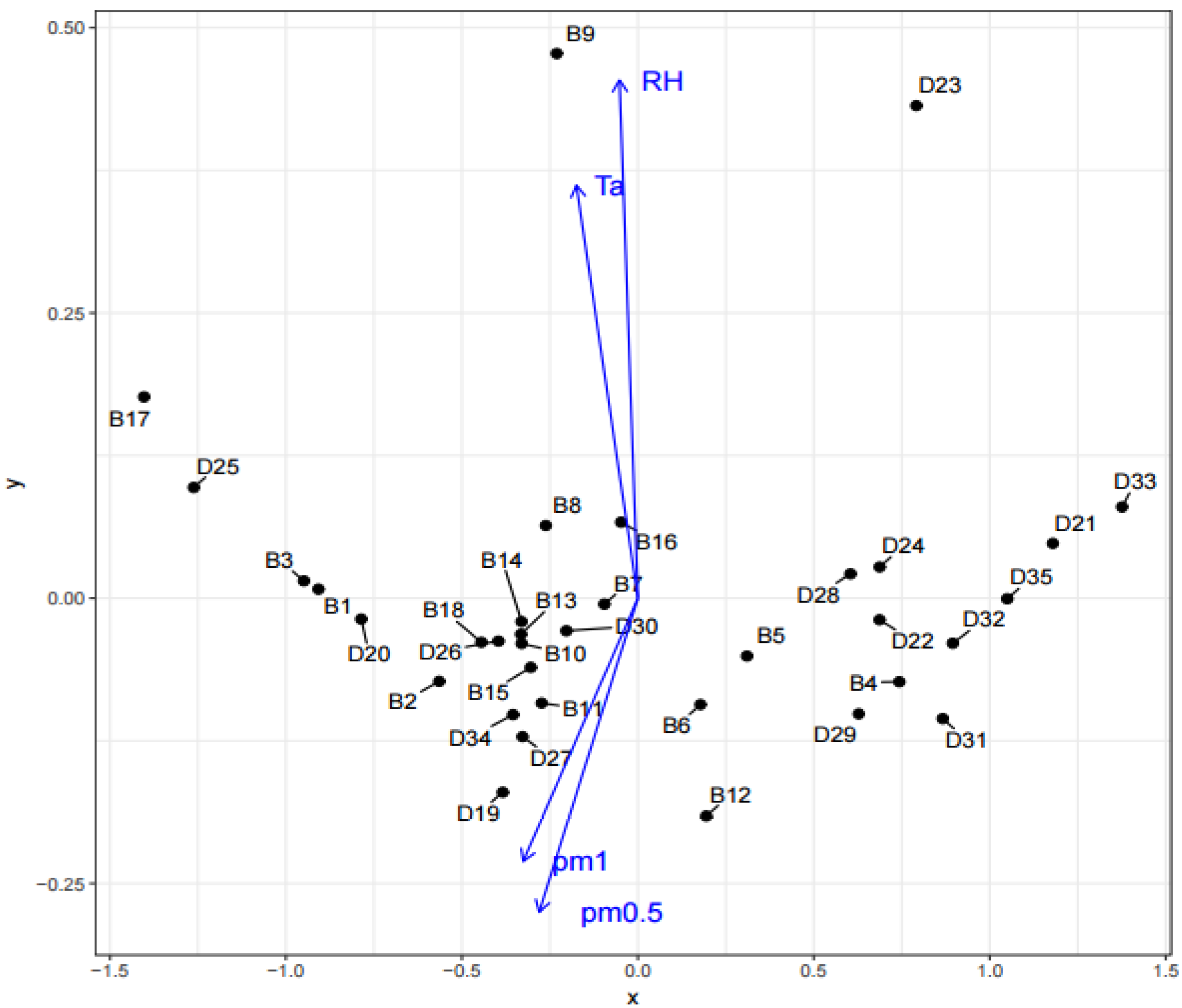

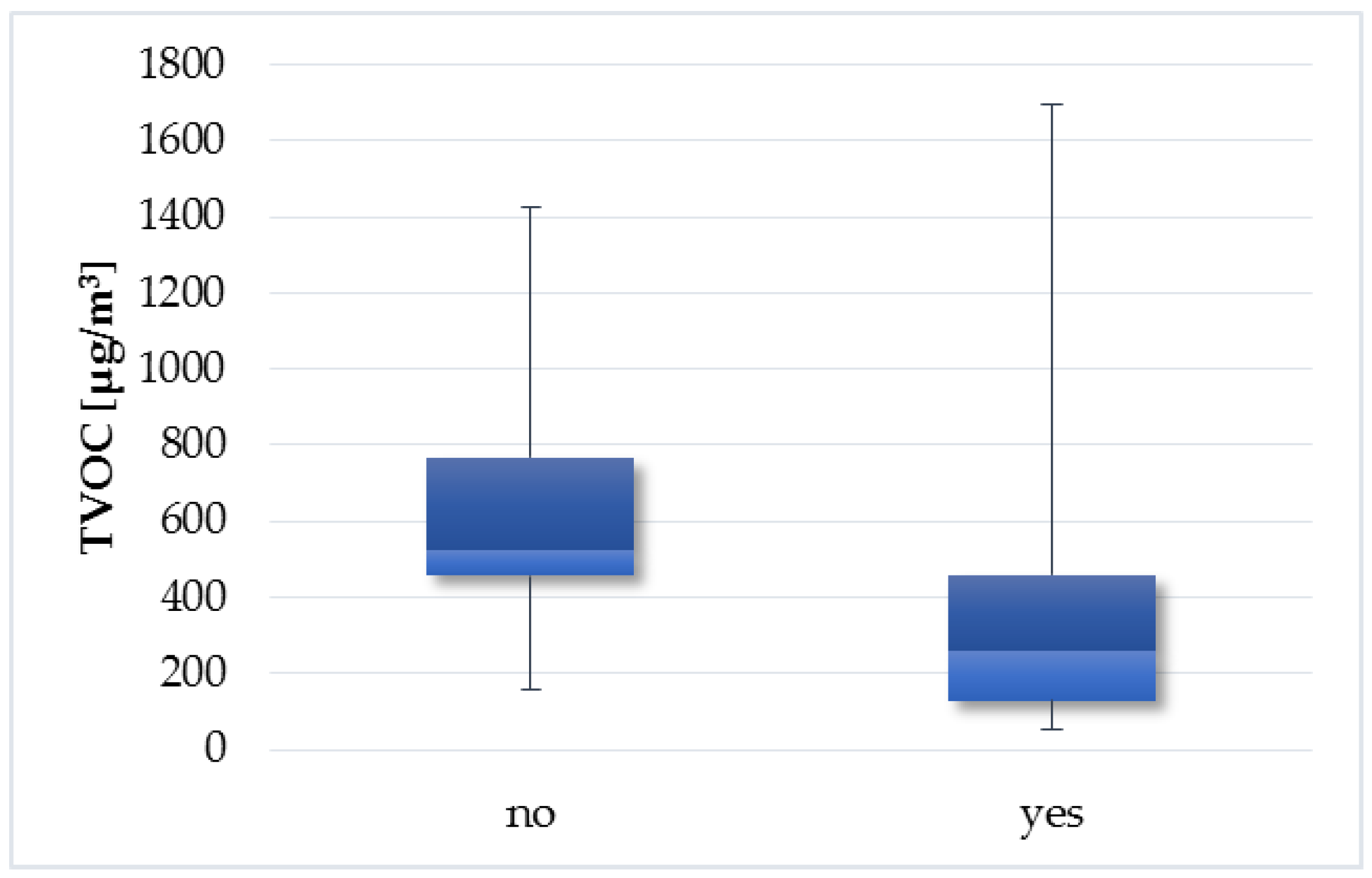
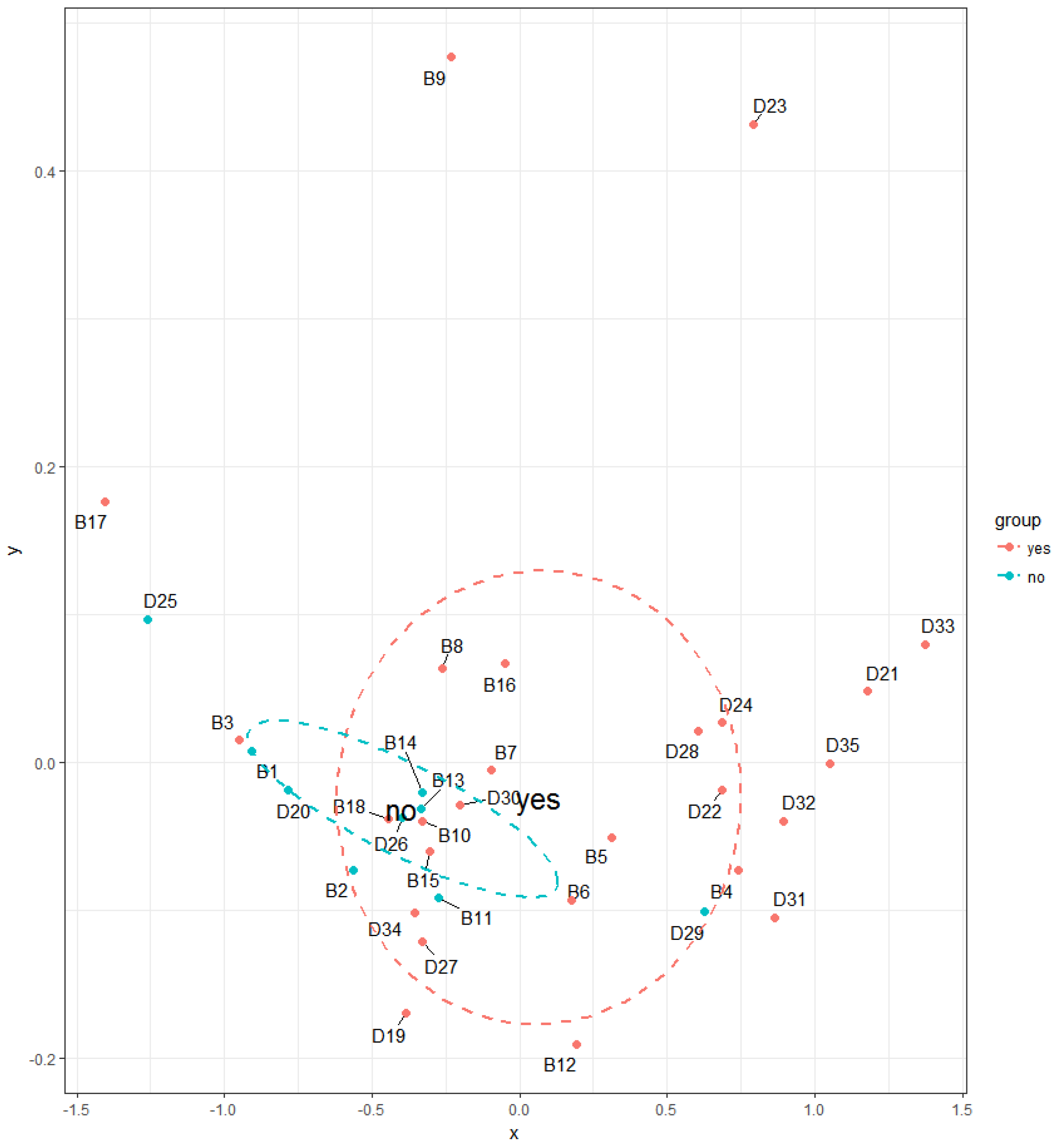
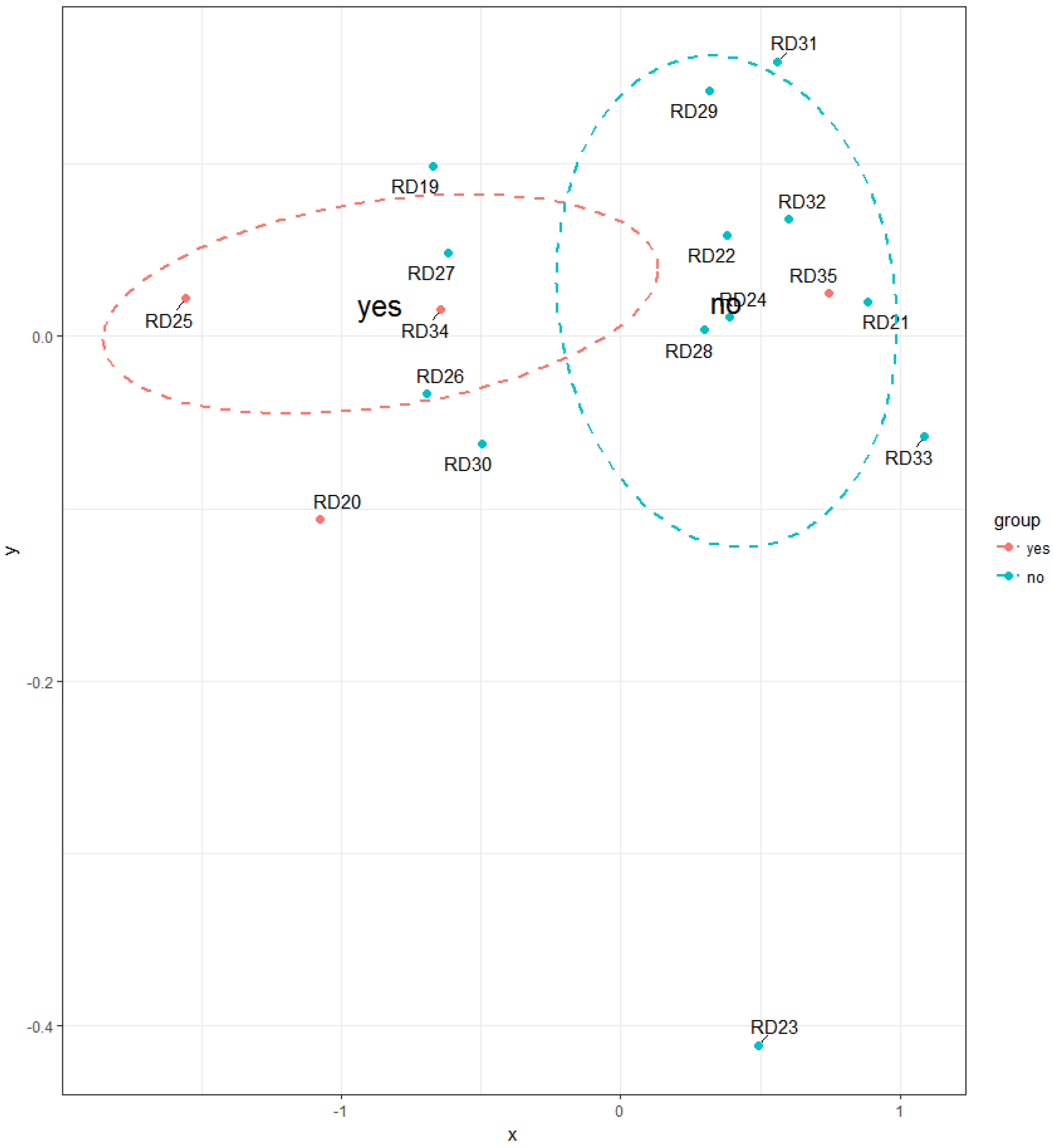
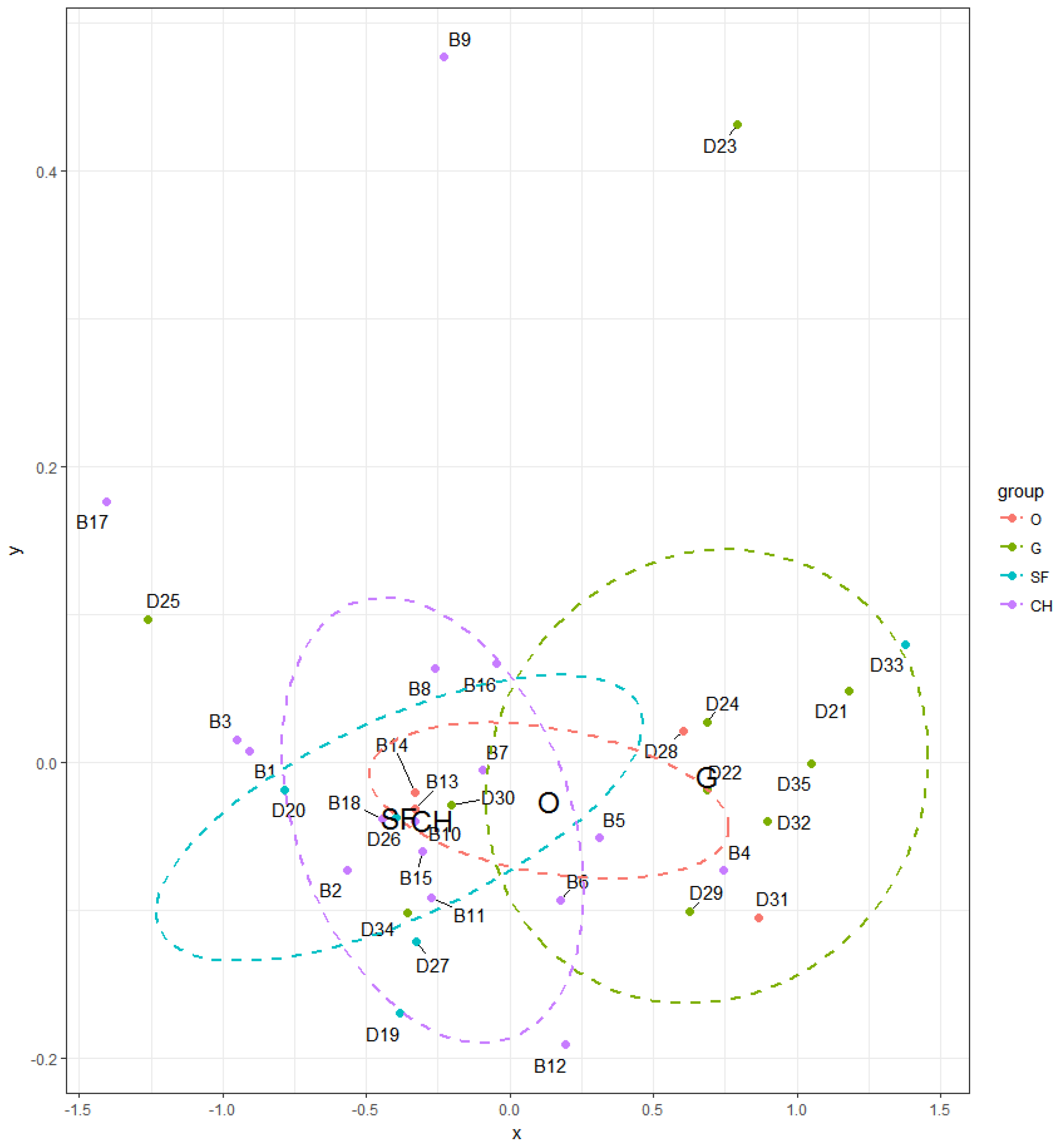
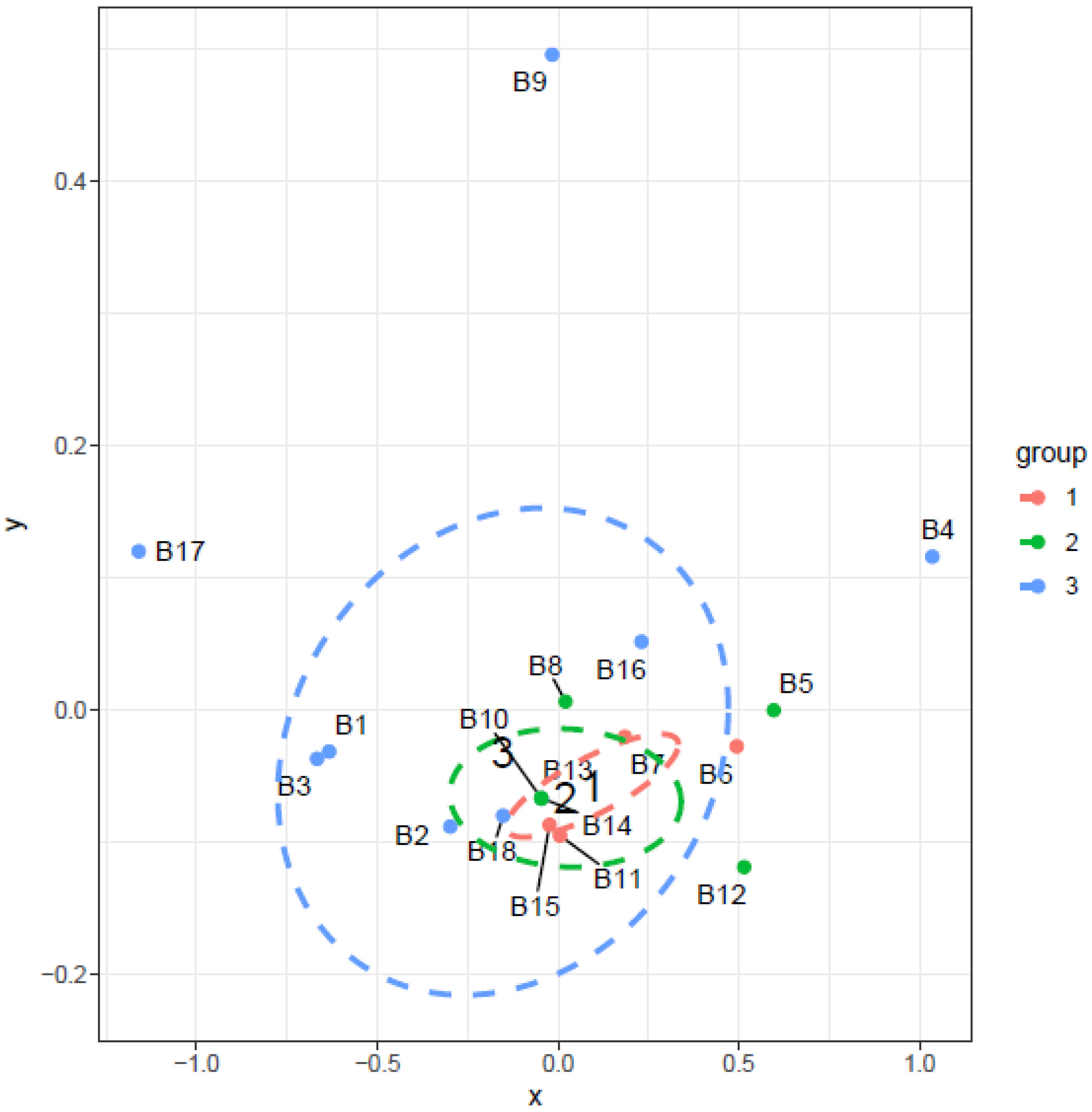
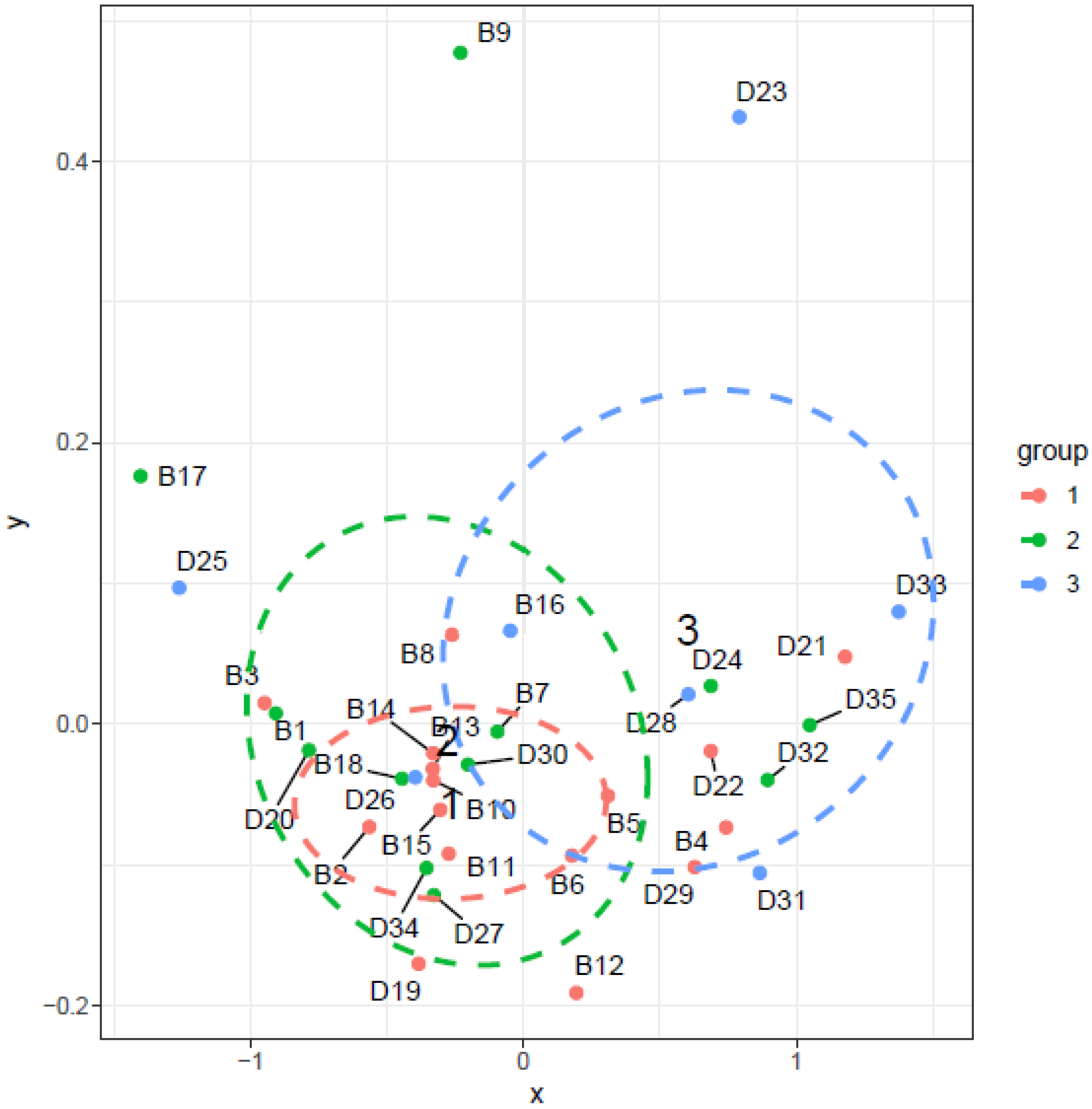
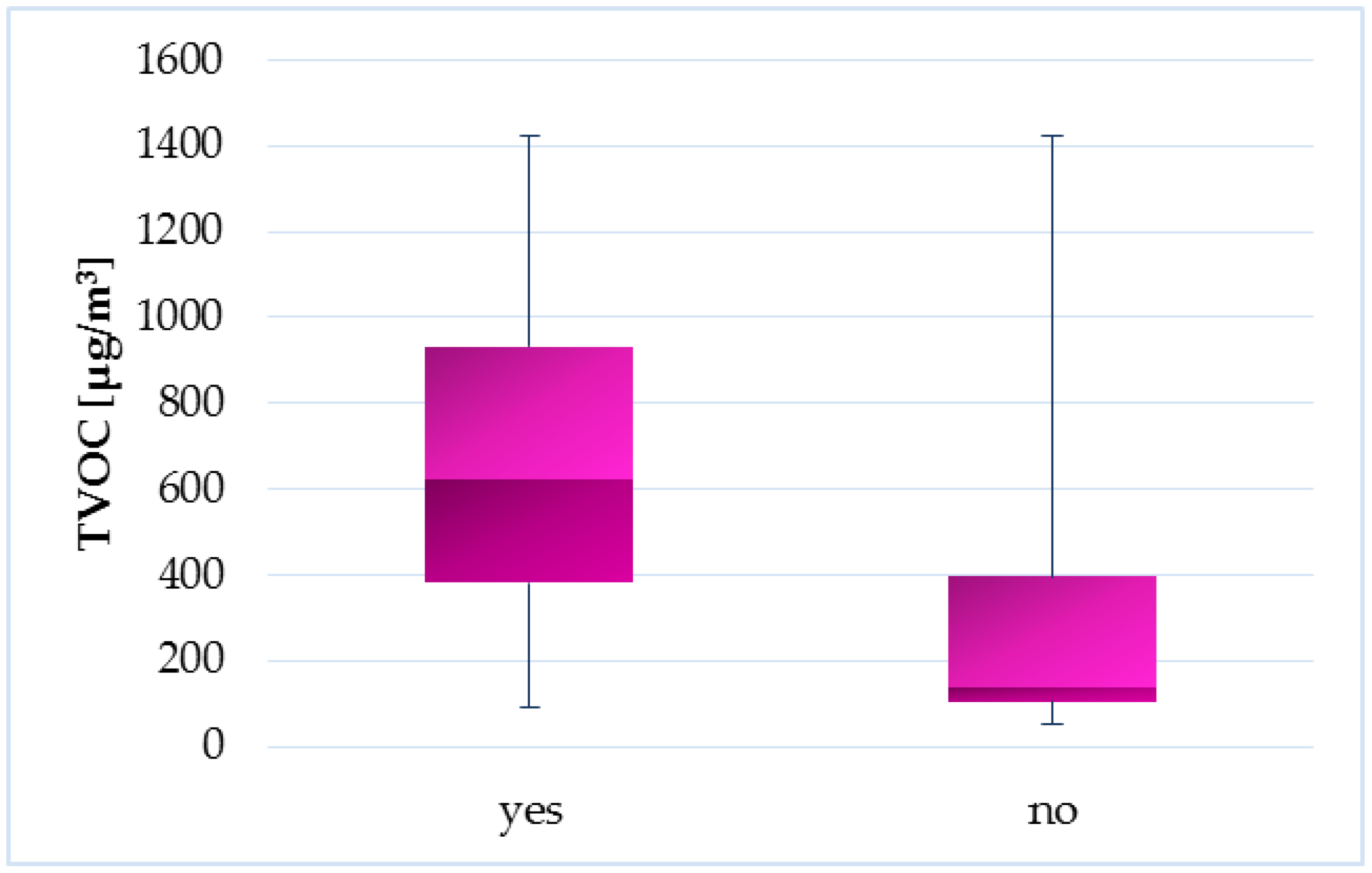
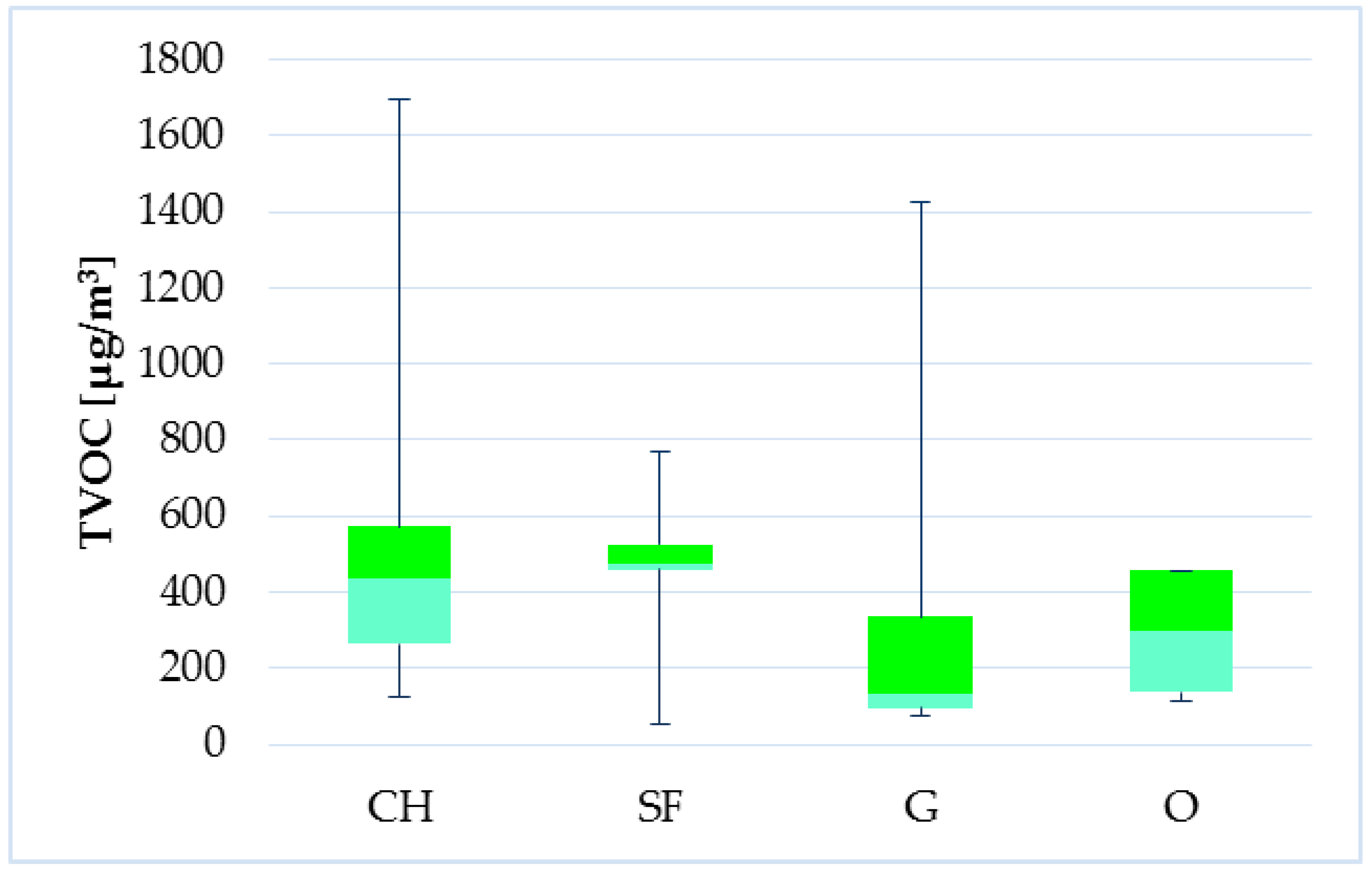
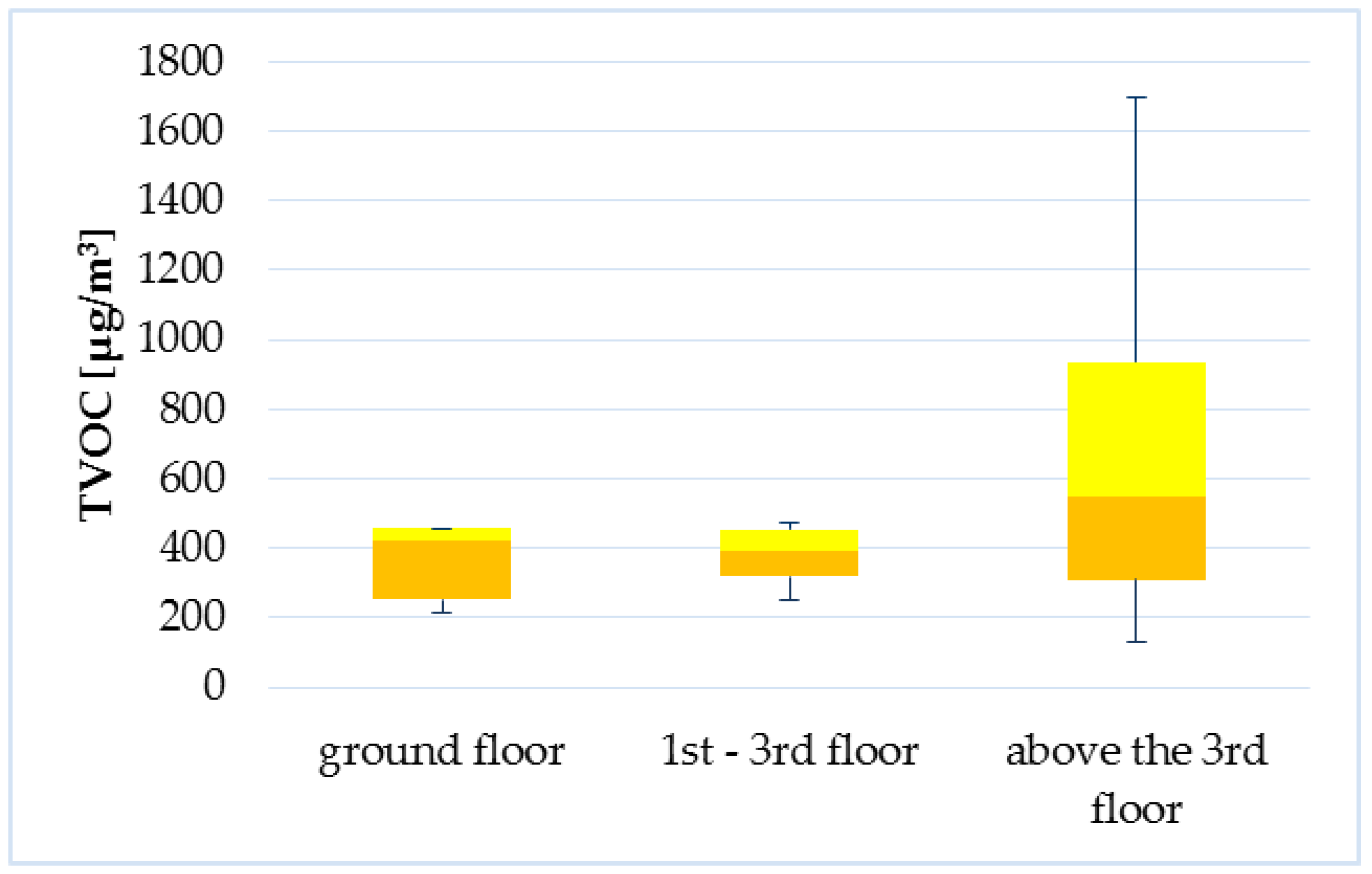

| Name | Unit | Range | Accuracy |
|---|---|---|---|
| TESTO 175-H2—Ta, Te | °C | −20~+70 | ±0.5 |
| TESTO 175-H2—RH | % | 0~100 | ±3 |
| HANDHELD 3016 IAQ | µm | 0.3~10 | 50% @ 0.3 μm; 100% for particles >0.45 μm (per ISO 21501-4) |
| Vernon-Jokl globe thermometer | °C | 0~50 | - |
| ppbRAE 3000 | ppm | 1~10,000 | ±3% in calibration point |
| Variables | r2 | p |
|---|---|---|
| Number of users | 0.1689 | 0.04895 * |
| Heating type | 0.1814 | 0.09091 |
| Windows opening during cleaning activities | 0.1555 | 0.01798 * |
| Floor of the apartments | 0.2741 | 0.06397 |
| Attached garage | 0.2148 | 0.05195 . |
| Temperature | 0.1614 | 0.04496 * |
| Relative humidity | 0.2088 | 0.01698 * |
| PM0.5 | 0.1544 | 0.07493 |
| PM1 | 0.1595 | 0.06893 |
| Variables | W | p |
|---|---|---|
| The apartments vs. family houses | 213 | 0.04865 * |
| Number of users smaller than 4 | 130 | 0.09933 . |
| Heating—SF and CH | 219 | 0.01461 * |
| Windows opening during cleaning activities | 50 | 0.01019 ** |
| Higher than 3rd floor in the residential building | 22 | 0.05675 * |
| Attached garage | 41 | 0.05084 * |
© 2017 by the authors. Licensee MDPI, Basel, Switzerland. This article is an open access article distributed under the terms and conditions of the Creative Commons Attribution (CC BY) license (http://creativecommons.org/licenses/by/4.0/).
Share and Cite
Mečiarová, Ľ.; Vilčeková, S.; Krídlová Burdová, E.; Kiselák, J. Factors Effecting the Total Volatile Organic Compound (TVOC) Concentrations in Slovak Households. Int. J. Environ. Res. Public Health 2017, 14, 1443. https://doi.org/10.3390/ijerph14121443
Mečiarová Ľ, Vilčeková S, Krídlová Burdová E, Kiselák J. Factors Effecting the Total Volatile Organic Compound (TVOC) Concentrations in Slovak Households. International Journal of Environmental Research and Public Health. 2017; 14(12):1443. https://doi.org/10.3390/ijerph14121443
Chicago/Turabian StyleMečiarová, Ľudmila, Silvia Vilčeková, Eva Krídlová Burdová, and Jozef Kiselák. 2017. "Factors Effecting the Total Volatile Organic Compound (TVOC) Concentrations in Slovak Households" International Journal of Environmental Research and Public Health 14, no. 12: 1443. https://doi.org/10.3390/ijerph14121443






